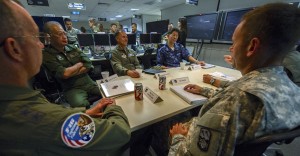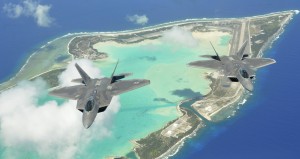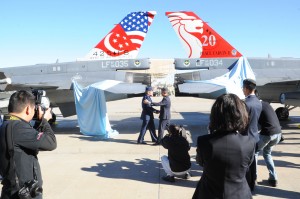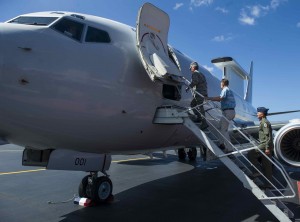2014-03-07 By Robbin Laird
I have spent the past week in discussions with the staff of the US Pacific Air Forces or PACAF.
I was able to sit down with Hawk Carlisle, the Commander PACAF towards the end of the week to pull a broader picture together from those conversations and to discuss the way ahead as seen from the command with regard to Pacific Defense.
The conversation on February 27, 2014 was just after the North Koreans had fired missiles into South Korean waters during an allied exercise for the defense of South Korea.
Deterrence in Depth
It is clear that several strands of activity – joint and coalition – are being woven together by the USAF with its joint and coalition partners.
In effect, the US is shaping a deterrence in depth strategy to ensure that the US national command authority has options to deal with threats in the Pacific and allies can have confidence in the viability of a vibrant US combat force in the Pacific.
Integration of Air and Missile Defense
The first strand is clearly a growing capability to integrate air and missile defense systems throughout the Pacific, including US Army, US Navy, US Air Force and allied systems. The effort is designed to shape an integrated collaborative force able to operate to deal with a wide range of missile threats.
According to General Carlisle:
The PACCOM Commander has put me in charge of how we are going to do integrated air and missile defense for the Pacific theater, which represents 52% of the world’s surface. This is clearly a major challenge and is clearly both a joint and coalition operation.
In an earlier interview, Brigadier General Daniel Karbler, 94th Army Air and Missile Defense Command, highlighted that the task of the Army role within an integrated enterprise as follows:
The role of having active defense or an interceptor force is to buy time for [Lieutenant] General [Jan-Marc] Jouas (7th USAF Commander in the Pacific) or General [Hawk] Carlisle (the PACAF Commander) to more effectively determine how to use their airpower. It also allows the National Command Authority to determine the most effective way ahead with an adversary willing to strike US or allied forces and territory with missiles.

General Carlisle focused on the way ahead to achieve the overall integrated air and missile defense mission designed to achieve the objectives outlined by BG Karbler.
We are pursuing an approach that combines better integration of the sensors with the shooters with command and control.
Command and control are two words.
The way ahead is clearly a distributed force integrated through command and control whereby one develops distributed mission tactical orders (with well understood playbooks) reflecting the commander’s directions and then to have the ability to control the assets to ensure that the sensors and shooters accomplish their mission.
Shaping an integrated enterprise is not a futuristic mission for the integration of Patriots, Aegis and THAAD is already a work in progress, but General Carlisle sees the approach getting better over time as new systems come to the Pacific, including a fleet of allied and US F-35s.
We need to get better at attack operations to take out the shooter.
How do we do that better?
It is clear that an F-35 fleet coupled with the new long range strike systems will play a key role in that function.
We also need to shape game changers in terms of the missiles used to intercept missiles.
The current generation is expensive and we need to drive down the cost point for interceptors.
SM-6 is coming which is an important asset but DOD is working hard on ways to drive down the cost of future interceptors.
And we are working the passive defense piece of the puzzle as well including hardening, concealment, dispersal of assets, rapid runway repair and support for a fluid force operating in a distributed manner.
General Carlisle underscored as well that the Command was working with allies to integrate those with assets and willingness to do so into the evolving capability. Indeed, there was a recent US-Japanese joint exercise, which worked directly on the integrated piece for air and missile defense, and with significant Japanese investments in such systems this is an obvious step forward.
And the South Koreans are obvious players as well with their Patriot and Aegis systems and with the Australians buying Aegis and F-35 they will be players as well in the future
The Impact of a US and Allied Pacific Fleet of F-35s
The roll out of the sensor-shooter C2 approach for an integrated air and missile defense system also lays down a capability that a decade from now when the fleet of allied and American F-35s is operational will be able to leverage as well.
By having shaped an approach towards integrated sensor-shooter relationships within which C2 was being worked, the F-35 as a sensor and shooter laid on top of that grid would be an immediate force multiplier.
General Carlisle was asked what would be the impact of a fleet of F-35s (allied and US) upon a Commander of PACAF a decade out.
It will be significant.
Instead of thinking of an AOC, I can begin to think of an American and allied CAOC (Combined Air Operations Center).
By sharing a common operating picture, we can become more effective tactically and strategically throughout the area of operations.
Dispersal and Distributed Operations

A key initiative fostered by General Carlisle is to work ways to disperse aircraft and to land aircraft on airfields from which they did not take off.
The Rapid Raptor concept where 4 F-22s are supported by a C-17 at an airfield different from where they took off is a clear indicator of the projected trend line.
From discussions earlier with the PACAF staff, it is clear that a major effort is underway to shape the logistics and support approach to allow for the operation of a dispersed air force executing a distributed operational approach throughout the region.
The Impact of Allied Modernization
Allied modernization efforts are a key part of the building of a 21st century Pacific defense approach.
General Carlisle has coined the term “places not bases” as his command’s way of discussing working with partners and allies throughout the region providing logistical support and coordinated capabilities which allow the US and those partners to work together in a variety of contingencies.

The exercise regime is clearly part of this effort, as exercises provide the opportunity to test out and enhance logistical and support approaches as well as to shape convergent con-ops where appropriate.
With regard to modernization, General Carlisle noted “this AOR is the most rapidly growing military aviation market worldwide. Investments are being made and the willingness of our allies to work with us in rolling out a common fleet of F-35s is a key common investment which will significantly enhance our collective ability to provide for effective Pacific defense.”
Among the investments being made by the allies which we discussed beyond missile defense and F-35 were tankers and the Aussie Wedgetail.
Several allies are either adding new tankers or plusing up their inventory of tankers and, according to Carlisle, “the allied tanker contribution is being enhanced and a more robust tanker fleet is a hugely positive development.”

He cautioned that to get the full benefit of more allied tankers would require working together to shape effective concepts of operations for a US and allied fleet working together.
We then discussed the new air battle management system bought and developed by the Aussies, the Wedgetail.
I have been on the aircraft and it has just recently participated in Red Flag 2014 It is a very capable aircraft, but when it first showed up at an allied exercise in 2010 it has serious challenges with regard to interoperability. There have been huge strides with regard to its capable to be interoperable.
There are two dynamics at work with regard to the shift.
The first was “the working relationship between the Australian Air Force (RAAF) and the USAF in focusing upon better integration of our various air battle management systems.”
The second is simply that the Wedgetail is a new generation of software upgradeable aircraft. The ability to evolve the capability of a software upgradeable aircraft (the F-35 is one as well) was highlighted in one of the RAAF interviews conducted by the Australian defense journalist Ian McPhedran in his book Air Force:
“Someone asked me, “When will we get the full technical maturity out of Wedgetail?
” I answered “never” because it will just continue to grow and the capability will be far greater in 30 years than what it is now.’
McPhedran, Ian (2011-08-08). Air Force (Kindle Locations 5776-5777). HarperCollins Publishers. Kindle Edition.
And translating Aussie working relationships with allies into software code is part of the process of enhancing capability over time.
The Unique USAF Role
General Carlisle closed by highlighting what he saw as a unique USAF opportunity within the evolving Pacific Defense.
The USAF is the only service in the US with decades of experience with stealth aircraft, with regard to how they work, how they change the operational reality for pilots and how they are sustained. Within the region, we can help allies to avoid paths which will not be optimal for their emerging fifth generation fleet of aircraft.
He highlighted as well that the learning path on which the F-22 has taken the USAF is important in ways other than simply air-to-air combat.
We have tested an F-22 with its sensors teeing up a T-LAM strike from a submarine against a moving target. This is the future, whereby the weapons on target are not simply carried by the aircraft but the forward based sensor can provide the moving target and over time those forward sensors can well have the ability to direct that weapon to the target.
For our new book on the evolution of Pacific strategy and re-setting the Pacific defense template see the following:
https://sldinfo.com/rebuilding-american-military-power-in-the-pacific-a-21st-century-strategy/
The book examines the challenge of re-shaping U.S. forces to deal with 21st century strategic realities for Pacific defense.
The book addresses three key questions:
What are the evolving challenges towards which American and allied capabilities need to evolve?
What kinds of policies will allies follow and what kinds of capabilities will they generate?
How best to coordinate and combine U.S. and allied capabilities to deal with the various challenges in the Pacific?
An earlier version of the article appeared on Breaking Defense.

